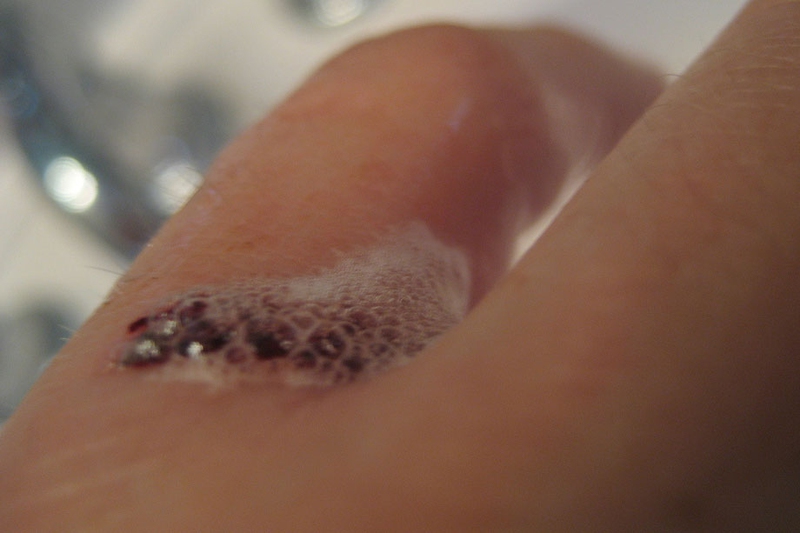It is easy to buy hydrogen peroxide (H2O2) from any drug store. What many people do not know is that they are not buying the purest form of hydrogen peroxide. They get a 3% solution, which means it contains 3% hydrogen peroxide and 97% water. It offers many benefits and is commonly used as an antiseptic. However, every time you dab hydrogen peroxide on a wound or cut, you notice white, fizzling foam. Why?
Why Does Hydrogen Peroxide Bubble?
The answer is that the fizzling foam you notice indicates that the solution is killing bacteria and healthy cells.
Hydrogen peroxide is made up of two oxygen and two hydrogen atoms. These atoms break apart after being exposed to blood and that causes stinging sizzle. It happens because blood contains the enzyme called catalase that attacks hydrogen peroxide and turns it into oxygen and water. The bubbles are basically the bubbles of oxygen gas produced after H2O2 is broken down by catalase found in blood. It is due to this reason only that you notice no bubbles when you pour peroxide on unbroken skin – it only reacts with blood.
It is important to understand that hydrogen peroxide is extremely reactive, so it comes with a shelf life. If you pour it on a cut and notice no bubbles, it indicates that peroxide is no longer active. You should go buy a new bottle of peroxide to clean your wound.
How Does Hydrogen Peroxide Work?
You already know the answer to, "Why does hydrogen peroxide bubble?" you may also want to how peroxide works. People have been using peroxide as an antiseptic since the 1920s. It works by destroying the cell walls of bacteria. The compound has oxygen atoms, which are incredibly reactive and attract electrons. The process is called oxidation that leaves fewer electrons in bacteria cells' walls, leaving them weak and damaged.
Warning: Hydrogen Peroxide Kills Healthy Cells
It is true that hydrogen peroxide has antiseptic properties, but you also need to bear in mind that it can also destroy healthy skin cells. It is for this reason that many dermatologists and experts do not encourage the use of hydrogen peroxide to clean wounds. They believe that the use of peroxide may slow the healing process and even make scarring worse by destroying the healthy cells.
The Better Alternative
Instead of using peroxide, you should use a saline solution to clean your wound as soon as possible. A saline solution is basically a 0.9% salt solution. If you do not have this solution available, simply use lukewarm tap water to clean the wound. Simply hold the wound under the running tap water until there is no dirt, debris, or bacterium left on the surface of your affected skin. Avoid scrubbing your wound with a washcloth or you may end up damaging it. This also increases the risk of infection. You should also avoid touching your open wound unless you are wearing medical gloves.
What about Other Hydrogen Peroxide Uses?
It Helps Treat Acne
You can use peroxide to treat your infected acne. It helps accelerate the healing process. Applying it directly on the infected site will kill the bacteria and clear the infection. Just make sure you do not overdo it. Applying it often may complicate the whole thing by killing the good bacteria as well.
It Helps Treat Canker Sores
Canker sores in the mouth can be extremely painful. You can treat them with the help of peroxide. Simply swishing hydrogen peroxide in your mouth will accelerate healing. Be sure to mix some water in it to avoid any irritation or blistering. Just swish it around for 30 seconds and spit it out. Finish by rinsing your mouth with fresh water.
It Helps Fight Foot Fungus
Dealing with foot fungus is never easy, but you can trigger healing by making use of hydrogen peroxide. It has antifungal properties and clear fungal infections quite efficiently. Mix equal parts of hydrogen peroxide and water and use this mixture on your feet to treat foot fungus.
It Clears Out Earwax
Earwax may not be an infection but it can become quite annoying, especially when it makes hearing difficult for you. Hydrogen peroxide is one great remedy not only to deal with ear infection but also to get rid of earwax. Mix a couple of drops of hydrogen peroxide with a couple of drops of olive oil and pour this mixture into your ear. Tile your head a bit and keep it in that position for a while to ensure the mixture stays in your ear. Change the position of your head and let the mixture drain out. Your ears will be clean now. Do not forget to use warm water to flush your ear out.
It Helps Keep Your Contact Lenses Clean
No matter how hard you try to keep your contact lenses clean, they will eventually gather dust and have a buildup of proteins as well. You can always use a commercial lens cleaner or you can try hydrogen peroxide. Many lens cleaners already contain hydrogen peroxide, so there is nothing wrong in using it to clean your contact lenses at home.
It Keeps Your Toilet Bowl Clean
Hydrogen peroxide works as a disinfectant and it works great to keep your toilet bowl clean. Simply take half a cup of peroxide and pour it in the bowl. Leave it for 20 minutes and then use your toilet brush to scrub it out. Flush… and you are done!



View All Comments /Add Comment